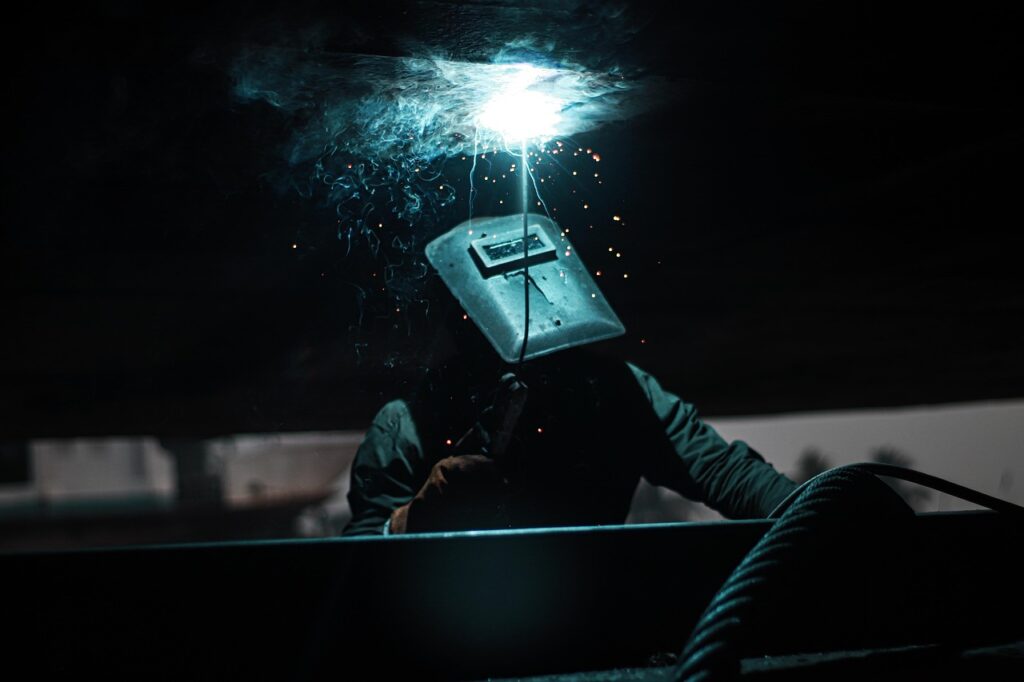
Metal parts hold our modern world together from bridges to aircraft frames. Industrial welding fabrication transforms raw steel and aluminum into complex structures that support critical infrastructure. Like surgeons who join living tissue with stitches, skilled welders fuse metal pieces creating bonds stronger than the original materials.
Why Precision Matters in Metal Work
Amateur welding attempts often result in weak joints that fail under stress or load. Industrial welding fabrication demands exactness where millimeter differences mean success versus catastrophic failure. Professional welders train for years mastering techniques that ensure structural integrity across thousands of demanding applications.
Advanced Welding Methods
TIG Welding Excellence
TIG (Tungsten Inert Gas) welding provides supreme control for thin materials and exotic metals. This process creates clean, precise welds on stainless steel, aluminum, and titanium requiring artistic skill. Aerospace and medical device industries rely on TIG for critical components where perfection isn’t optional.
MIG Welding Speed
MIG (Metal Inert Gas) welding delivers faster production suitable for thicker materials and long seams. This versatile method handles steel and aluminum with consistent quality across repetitive tasks. Auto manufacturing and heavy equipment fabrication depend on MIG for efficient high-volume output.
Robotic Automation
Modern facilities employ robotic welders executing perfect repetitive welds without fatigue or variation. These systems work around the clock maintaining consistency human welders cannot match through long shifts. Automation frees skilled welders for complex custom work requiring human judgment and adaptability.
Material Selection Expertise
Carbon Steel Versatility
Standard steel remains the workhorse material for structural fabrication across construction and manufacturing sectors. Its strength, weldability, and cost balance make it ideal for frames, brackets, and general structures. Proper welding techniques prevent warping while maintaining structural properties throughout assemblies.
Stainless Steel Durability
Corrosion-resistant stainless suits food processing, medical equipment, and marine applications requiring hygiene and longevity. Special techniques prevent heat discoloration and maintain material properties during welding processes. Higher costs justify themselves through extended service life in demanding environments.
Aluminum Lightweight Strength
Aluminum fabrication serves industries valuing weight reduction like aerospace, automotive, and transportation equipment. This metal requires different techniques than steel due to thermal conductivity and oxide layer properties. Skilled welders adapt their approach matching material characteristics for optimal results.
Quality Control Standards
Visual Inspection
Trained inspectors examine every weld checking for cracks, porosity, and proper penetration depth. Surface defects signal deeper problems requiring repair before parts enter service or assembly. Thorough visual checks catch most issues preventing expensive failures down production lines.
Non-Destructive Testing
X-ray, ultrasound, and magnetic particle testing reveal internal defects invisible to naked eyes. These advanced methods verify weld integrity without destroying finished parts or assemblies. Critical applications like pressure vessels and aircraft components demand this level of scrutiny.
Certification Requirements
Many industries require certified welders holding credentials proving competency in specific processes and materials. Testing ensures welders can consistently produce code-compliant work meeting safety and quality standards. Certifications protect public safety while validating professional expertise.
Custom Fabrication Services
Prototype Development
Elite shops transform engineering drawings into physical prototypes for testing and refinement before production. This iterative process identifies design issues early when changes cost less than after tooling investment. Rapid prototyping accelerates product development cycles significantly.
Production Runs
After prototype approval, fabricators scale up producing identical parts meeting tight tolerance specifications. Consistent quality across hundreds or thousands of pieces requires process control and skilled oversight. Production expertise separates professional shops from amateur operations attempting commercial work.
Repair and Modification
Experienced fabricators restore worn equipment and modify existing structures adapting them for new purposes. This work often proves more challenging than new fabrication requiring creativity and problem-solving skills. Repair expertise extends equipment life while avoiding expensive replacements.
Safety Protocol Emphasis
Personal Protection
Welders wear specialized helmets, gloves, and clothing protecting against intense light, heat, and sparks. Proper ventilation removes toxic fumes preventing respiratory damage from prolonged exposure. Safety equipment represents critical investment protecting workforce health and productivity.
Fire Prevention
Hot work permits, fire watches, and proper material storage prevent devastating fires in fabrication facilities. Welding sparks travel far igniting combustibles unless proper precautions get followed consistently. Safety culture prioritizes prevention over emergency response after incidents occur.
Industry Applications
Construction Structural Steel
Buildings and bridges rely on precision-welded steel frames supporting enormous loads safely for decades. Structural welding follows strict codes ensuring public safety through engineering and quality assurance. This foundational work literally holds up our built environment.
Manufacturing Equipment
Custom machinery and production equipment require fabricated frames, brackets, and specialized components throughout. Precision welding ensures equipment operates smoothly under constant use and mechanical stress. Quality fabrication reduces downtime through reliable component performance.
Energy Sector Infrastructure
Power plants, pipelines, and renewable energy systems depend on high-quality welding for safe reliable operation. Pressure vessels, turbine components, and structural supports demand the highest fabrication standards. Energy infrastructure failures carry enormous consequences making precision non-negotiable.
Technology Integration
Computer-Aided Design
Modern fabricators use CAD software creating detailed 3D models before cutting or welding begins. Digital planning optimizes material usage while identifying potential assembly problems early in processes. Technology integration improves accuracy while reducing waste and rework costs.
CNC Cutting Systems
Computer-controlled plasma, laser, and waterjet cutters produce precisely shaped pieces ready for welding assembly. Automated cutting ensures repeatability while freeing skilled workers for tasks requiring human judgment. This efficiency improves both quality and production speed significantly.
Your projects deserve welding expertise that combines traditional craft skills with modern technology. Elite fabricators deliver precision work supporting critical applications where failure isn’t an option.




